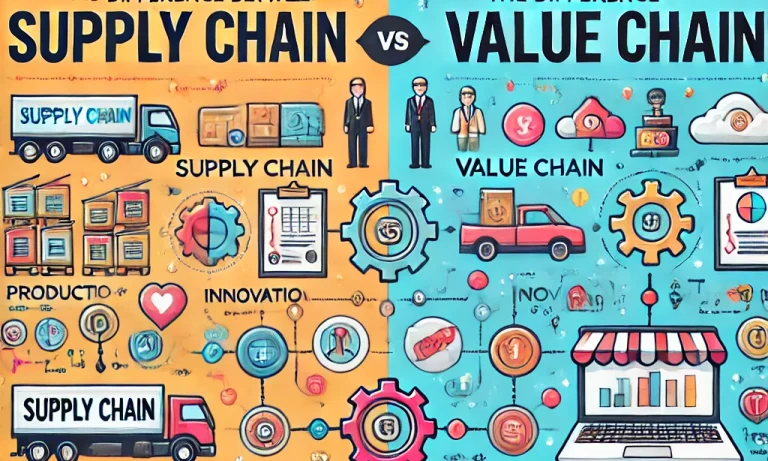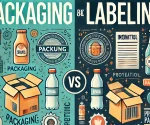Value chains differ from supply chains in their purpose and the ways by which each system increases value for a business. They are both integral aspects in the production and provision of goods and services although in different contexts. In definition, the supply chain involves a network of people, organizations, technology, activities, and resources necessary for moving a product along a chain from raw material to the final consumer. On the other hand, the value chain is concerned with the internal processes a company uses to add value to its products or services, which finally leads to a competitive advantage. Understanding these differences will enable businesses to optimize their operations, enhance efficiency, and deliver superior value to their customers.
Difference Between Supply Chain and Value Chain
The supply chain is an end-to-end system that involves the movement of goods from raw materials to the final consumer. It focuses on the logistics, transportation, procurement, and distribution of products. The supply chain focuses on efficiency and cost management. Its goal is to ensure that the product reaches the consumer in the most timely and cost-effective way possible. Generally, supply chain processes cut across many external firms, including suppliers, manufacturers, distributors, and retailers.
The value chain is more inward-focused as it relates to the activities that are within a firm and that make up value. A value chain is a set of activities that a business undertakes in transforming raw materials into final products or services that bring value to customers. It involves product design, production, marketing, sales, and after-sales services. The whole purpose of the value chain is to add value at every stage that will result in a competitive advantage. In contrast to the supply chain, which focuses on optimizing for cost-effectiveness, the value chain puts more emphasis on differentiation and value-added processes.
| Aspect | Supply Chain | Value Chain |
|---|---|---|
| Focus | Logistics, procurement, and delivery of goods | Internal processes that add value to a product |
| Goal | Efficiency and cost management | Value creation and competitive advantage |
| Scope | External processes (suppliers, distributors, etc.) | Internal processes within the company |
| Key Activities | Sourcing, production, logistics, and distribution | Design, production, marketing, and after-sales |
| Cost or Differentiation | Focus on cost reduction | Focus on adding value at each step |
| Perspective | External, transactional | Internal, strategic |
Value Chain Meaning
The value chain is the full range of activities a business performs to bring a product or service from conception to delivery. It includes everything from raw material procurement to final product design and post-sale services. Every step in the value chain must add value to the product to contribute to the company’s competitive advantage. This strategic approach develops products with functionality and value. Though differentiated enough that they attract attention in a market and stand out on their merits.
The theory of value chain was created by Michael Porter in 1985 in his work, Competitive Advantage. In the above work, he states how the creation of value for a business product distinguishes it from those of similar businesses. By streamlining processes in its value chain, a company can gain a competitive advantage and thus deliver more value to the customer. For instance, a firm that enhances product design is able to fetch a better price for its products compared to its peers while adding value not only during production. But also in terms of customers’ perception of the value added.
Primary Activities
These are the activities directly involved in the production and delivery of the product or service:
- Inbound Logistics: Receiving, storing, and managing raw materials.
- Operations: Transforming raw materials into the finished product.
- Outbound Logistics: Distributing the finished product to customers.
- Marketing and Sales: Promoting and selling the product to the customer.
- Service: Providing post-sale support, such as maintenance and repairs.
Support Activities
These activities provide the necessary support for primary activities and contribute indirectly to value creation:
- Procurement: Acquiring resources needed for the primary activities.
- Technology Development: Innovating and improving processes and products.
- Human Resources Management: Hiring and training staff to enhance operational efficiency.
- Firm Infrastructure: Company-wide systems and processes that support all other activities.
Optimizing each of these activities can increase a company’s profitability by reducing costs, improving customer satisfaction, or differentiating the product.
Supply Chain
The supply chain is the entire process of producing and delivering goods or services, from raw material sourcing to final delivery to the consumer. It is a network of suppliers, manufacturers, distributors, and retailers working together to ensure that the product reaches the end user at the right time and in good condition.
A company’s supply chain management is a part of its overall business strategy. Proper supply chain management can help reduce costs and improve quality and delivery speed. All of this plays a key role in building a competitive advantage. Thus, the primary objective of the supply chain is that all product components are made available with minimal disruption, at the lowest possible cost, when needed.
The processes involved in a supply chain often include:
- Sourcing and Procurement: Identifying suppliers, negotiating contracts, and acquiring raw materials.
- Manufacturing: Converting raw materials into finished goods through production processes.
- Storage and Inventory Management: Storing goods in warehouses and managing stock levels.
- Logistics and Distribution: Transporting goods to retail locations or directly to customers.
- Retail and Customer Delivery: The final step in the supply chain where goods reach the end customer.
The primary objective of supply chain management is to have an efficient flow of goods and services, from procurement through manufacturing to distribution. These efficiencies are achieved through technologies such as inventory management systems, supply chain software, and automated production lines.
Besides efficiency, supply chain management also focuses on flexibility, risk management, and adaptability. Global supply chains are exposed to geopolitical risks, natural disasters, and supply disruptions.
Supply Chain and Value Chain FAQs
What is the main difference between supply chain and value chain?
The main difference between supply chain and value chain is that the supply chain focuses on the movement of goods from suppliers to customers, while the value chain is about adding value at each step of the internal processes to create a product that stands out in the market.
How does value chain contribute to competitive advantage?
The value chain contributes to competitive advantage by optimizing internal processes like product design, production, and marketing to increase the overall value offered to customers, which can lead to higher customer satisfaction and loyalty.
Is supply chain management more focused on cost or differentiation?
Supply chain management is primarily focused on reducing costs and improving efficiency through the optimization of logistics, procurement, and distribution processes. Unlike the value chain, which focuses on differentiation, the supply chain targets cost-effectiveness.
Can a company have an efficient supply chain but a weak value chain?
Yes, a company can have an efficient supply chain but a weak value chain. In such cases, the company may efficiently deliver products to customers but may fail to create sufficient value through its internal processes, which can affect its competitive position.
Why is the value chain important for a business?
The value chain is important for a business because it helps identify areas where value can be added at each stage of the production process. Optimizing these areas can improve the quality of the product, reduce costs, and increase profitability.


